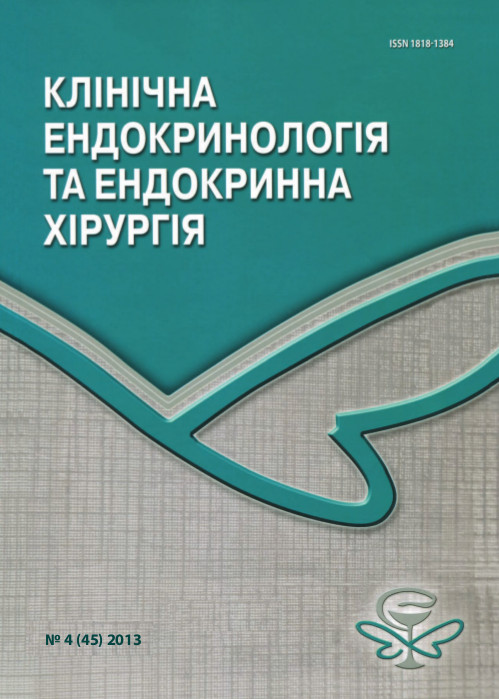Особливості розподілу жирової тканини у хворих на цукровий діабет 2-го типу з ожирінням та артеріальною гіпертензією
DOI:
https://doi.org/10.24026/1818-1384.4(45).2013.78328Ключові слова:
diabetes mellitus type 2, obesity, dual-energy X-ray absorptiometryАнотація
The research, studied the correlation between mass of adipose tissue (its distribution at the abdominal and gluteofemoral areas) and the anthropometric indexes (body mass index (BMI), waist circumference (WC), hip circumference (HC) and waist-hip ratio) of 53 patients with diabetes mellitus type 2, with obesity and arterial hypertension. Determination of adipose tissue distribution in the body was conducted by the method of dual-energy X-ray absorptiometry and routine anthropometric measuring. ANOVA analysis revealed the differences in general and local body fat mass distribution and some antropometric characteristics related with patients' gender. Application of regression analysis showed the positive association of BMI with body mass of adipose tissue, as well as with adipose tissue localized in abdominal and gluteofemoral areas. It is necessary to take into account that sexual dimorphism and inherited factors mostly predetermine the fat distribution at waist and hips as well as WHR when use the above mentioned anthropometric indexes for the estimation of degree and type of obesity. The conclusion about close relation between some anthropometric indexes and indexes of body fat mass, evaluated by dual-energy X-ray absorptiometry, is observed when the general mass of adipose tissue does not exceed 50% of body weight.
Посилання
Рекомендації Української асоціації кардіологів з профілактики та лікування артеріальної гіпертензії. Посібник до Національної програми профілактики і лікування артеріальної гіпертензії. – К.: ПП ВМБ, 2008. – 80 с.
Preis S.R., Hwang S.J., Coady S. et al. Trends in all-cause and cardiovascular disease mortality among women and men with and without diabetes mellitus in the Framingham Heart Study, 1950 to 2005 // Circulation. – 2009. – Vol. 119. – С. 1728-1735. https://doi.org/10.1161/circulationaha.108.829176
Go A.S., Mozaffarian D., Roger V.L. et al. Heart disease and stroke statistics – 2013 update: a report from the American Heart Association // Circulation. – 2013. – Vol. 127. – P. e6-e245. https://doi.org/10.1161/cir.0b013e31828124ad
Daousi C., Casson I.F., Gill G.V. et al. Prevalence of obesity in type 2 diabetes in secondary care: association with cardiovascular risk factors // Postgrad. Med. J. – 2006. – Vol. 82. – P. 280-284. https://doi.org/10.1136/pmj.2005.039032
Chobanian A.V., Bakris G.L., Black H.R. et al. Joint National Committee on Prevention, Detection, Evaluation, and Treatment of High Blood Pressure; National Heart, Lung, and Blood Institute; National High Blood Pressure Education Program Coordinating Committee 2003 Seventh report of the Joint National Committee on Prevention, Detection, Evaluation, and Treatment of High Blood Pressure // Hypertension. – 2003. – Vol. 42. – P. 1206-1252. https://doi.org/10.1161/01.hyp.0000107251.49515.c2
Grundy S.M. Obesity, Metabolic Syndrome, and Cardiovascular Disease // The Journal of Clinical Endocrinology & Metabolism. – 2004. – Vol. 89. – P. 2595-2600. https://doi.org/10.1210/jc.2004-0372
Seidell J.C., Verschuren W.M., van Leer E.M., Kromhout D. Overweight, underweight, and mortality. A prospective study of 48,287 men and women // Arch. Intern. Med. – 1996. – Vol. 156(9). – P. 958-963. https://doi.org/10.1001/archinte.156.9.958
Bastard J.P., Antuna-Puente B., Feve B., Fellahi S. Adipokines: The missing link between insulin resistance and obesity // Diabetes Metab. – 2008. – Vol. 34(1). – P. 2-11. https://doi.org/10.1016/j.diabet.2007.09.004
Bosello O., Zamboni M. Visceral obesity and metabolic syndrome // Obes. Rev. – 2000. – Vol. 1. – P. 47-56. https://doi.org/10.1046/j.1467-789x.2000.00008.x
Albanese C.V., Diesel E., Genant H.K. A review: clinical application of body composition measurements using DXA // J. Clin. Densit. – 2003. – Vol. 6. – P. 161-172. https://doi.org/10.1385/jcd:6:2:75
Johnson P.R., Greenwood M.R.C. The adipose tissue. In: "Cell and Tissue Biology: A Textbook of Histology / ed. by L. Weiss, 6th edition. – Urban and Schwarzenberg, Baltimore, 1988. – P. 191-209.
Francine G.M., Smas C.M., Hei Sook Sul. Understanding Adipocyte Differentiation // Physiol. Rev. – 1998. – Vol. 78. – №3.- P. 783-809.
Direk K., Cecelja M., Astle W. et al. The relationship between DXA-based and anthropometric measures of visceral fat and morbidity in women // BMC Cardiovascular Disorders. – 2013. – Vol. 13. – P. 25. https://doi.org/10.1186/1471-2261-13-25
Fox C.S., Massaro J.M., Hoffmann U. et al. Abdominal visceral and subcutaneous adipose tissue compartments – Association with metabolic risk factors in the Framingham Heart Study // Circulation. – 2007. – Vol. 116(1). P. 39-48. https://doi.org/10.1161/circulationaha.106.675355
Heid I.M., Jackson A.U., Randall J.C., Winkler T.W. Meta-analysis identifies 13 new loci associated with waist-hip ratio and reveals sexual dimorphism in the genetic basis of fat distribution // Nature Genetics. – 2010. – Vol. 42. – P. 949-960. https://doi.org/10.1038/ng.685
##submission.downloads##
Опубліковано
Номер
Розділ
Ліцензія
Авторське право (c) 2017 Клінічна ендокринологія та ендокринна хірургія

Ця робота ліцензується відповідно до Creative Commons Attribution-NonCommercial 4.0 International License.





